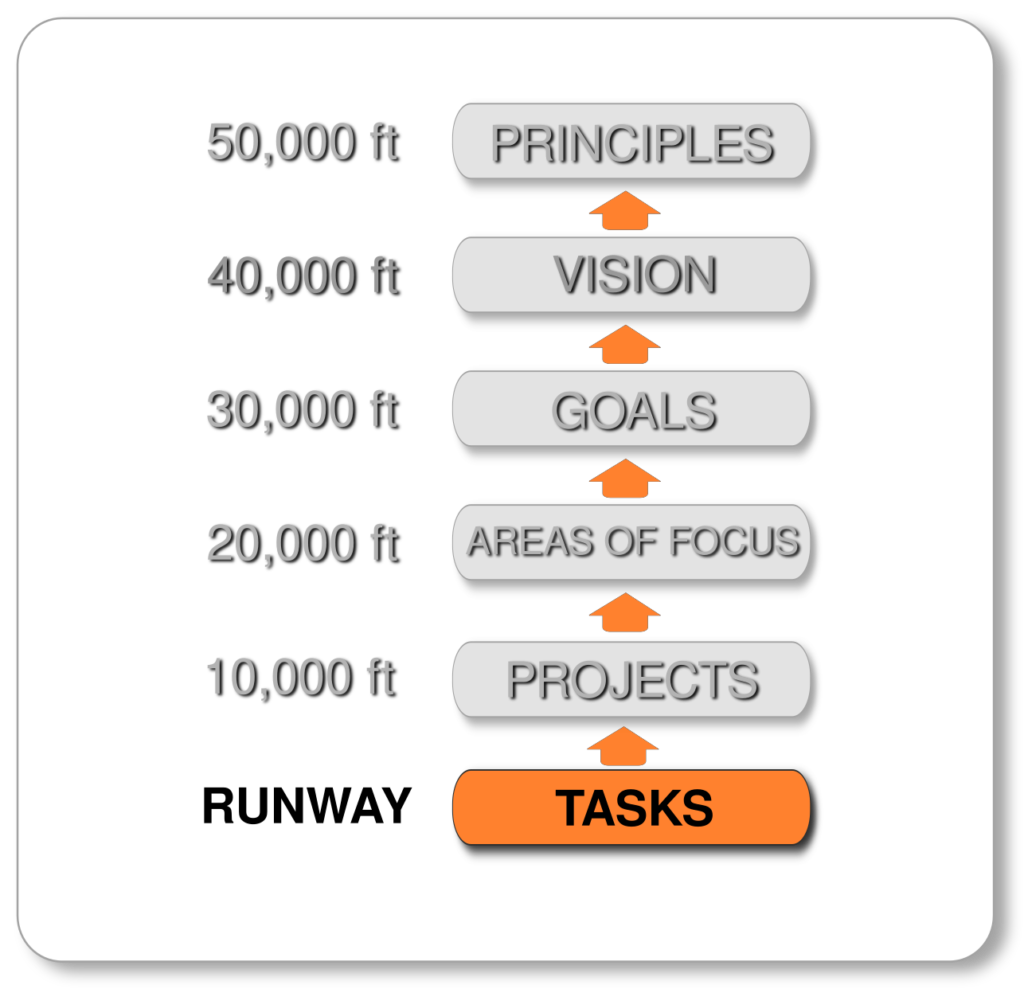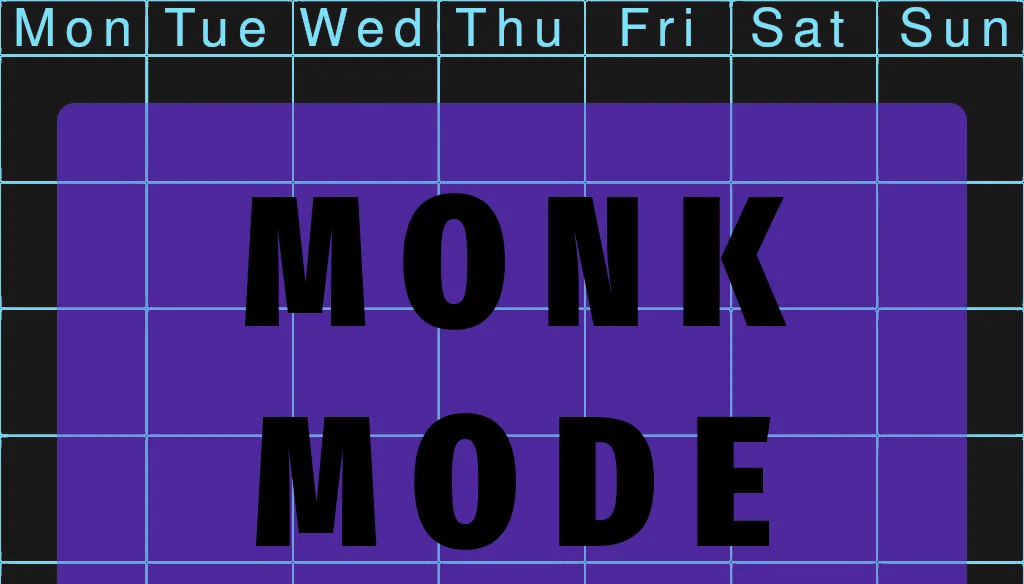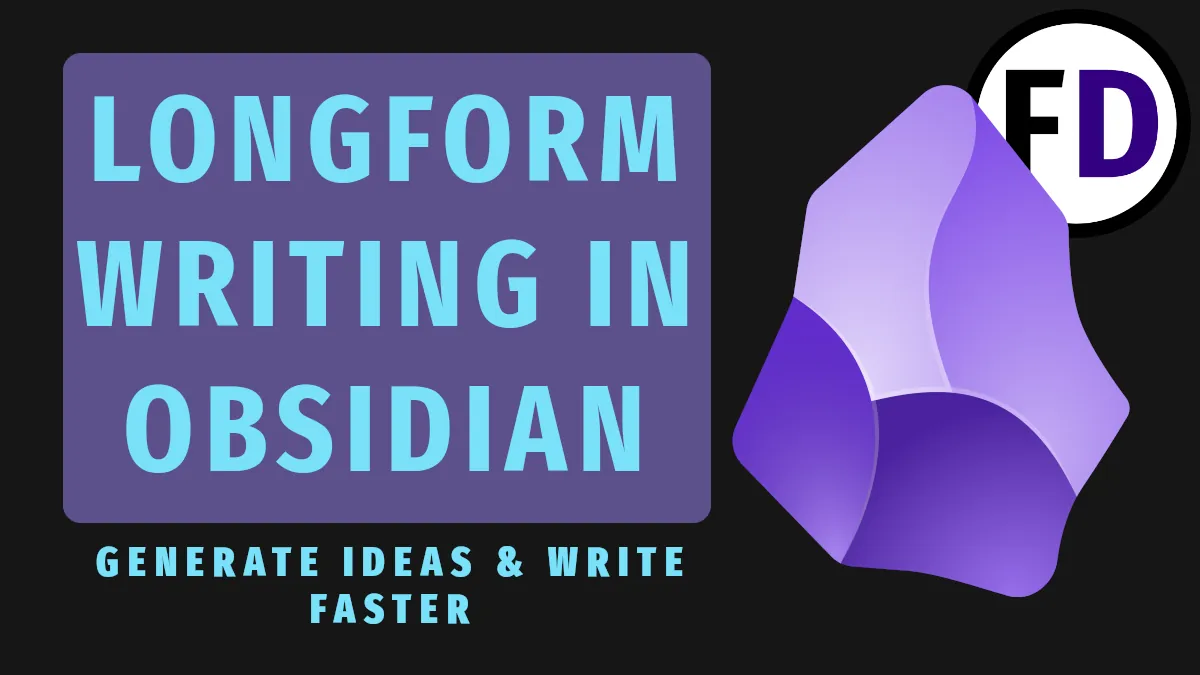Getting Things Done offers many different methods to get control and perspective of your life, to do more and engage more efficiently. But how do we go about problem solving with GTD?
Problems solving with GTD can be done using the 6 horizons of focus, by redefining the problem at each horizon and then attempting to solve each of those newly defined problems. The result is a solution to your problem that will solve the problem across time.
What Are the Horizons of Focus?
Runway – The perspective of Next actions

The Runway is the here and now, the lowest level of the horizons of focus. This is where you should be most of your day, doing what needs to be done.
10,000 Feet – The perspective of Projects
10,000 Feet is the Projects level. At 10,000 feet you are no longer doing, you’re looking down now with a tactical advantage to make the decisions so that you can be productive once you’re back on the runway. Here you should be thinking about the things you need to complete, this might include action that will need to be taken in the near future and planning how and when you will get things done.
20,000 Feet – The perspective of Areas of Focus
Now at 20,000 feet, you’re above even the things you need to complete. Here there is nothing to be done or finished, this is the perspective of the areas of your life that need to be maintained. Finances for examples, is not something you can complete, it’s just an area of your life that needs focus. You have 7-15 of these areas and in this horizon you can consider how well maintained they are.
30,000 Feet – The perspective of Goals
The horizon of goals takes us way into the future. This is the horizon of 5-10 years into the future, the larger accomplishments you want for your life belong here.
40,000 Feet – The perspective of Life Vision
The perspective of Life Vision is so far away from the day to day tasks we all get so involved in that from here we can barely see the runway anymore. But it’s still down there. This is the perspective of what do I want my life to be like. Where I want to live, who I want to marry, do I want kids. If it’s going to fundamentally affect your life, it’s 40,000 feet.
50,000 Feet – The perspective of Life Purpose or Principles
Finally we have the highest perspective, that of Life Purpose. Knowing what your life purpose of core principles are can certainly be helpful when making decisions or problem solving. But if you are not sure yet what your life purpose is, don’t worry! You’re in good company.
Why Use the Horizons of Focus to Problem Solve?

The horizons of focus as laid out by David Allen in Getting Things Done were not intended to be a problem solving tool. They are a tool to give perspective across the various time frames of your life.
Jordan Peterson’s gives this advice when asked how one should act morally “Do what’s best for you now and in the future while also being best for your family now and in the future and best for the greater society now and in the future.”
To be able to identify such an act, one would need a model that encapsulates the various aspects of ones life, including your family and the greater society and also which spans across time. I.e. the horizons of focus.
From the runway to goals and life vision, the horizons of focus obviously deal with time starting in the now stretching out to the end of your life. The aspects of family and the greater society are also encapsulated within the areas of focus and the degree to which your core principles involve society at large.
It could be argued that there is a difference between acting morally and problem solving though. Peterson would seem to argue otherwise though as for him the greatest moral imperative is to “reduce suffering.” I would say that problems tend to increase suffering and so problem solving is tantamount to reducing suffering and acting morally.
A simpler reason for why should we use the horizons of focus to problem solve would be that you generally speaking, you don’t want to solve a problem now for it to come back stronger in the future. Better to instead solve a problem across time frames so that you can be rid of it once and for all.
How To Do It – 4 Steps
1. Define the root problem by asking why
Defining the root problem is always the best way to start to solve a problem. It is sometimes so easy to look at a problem at face value such as “I don’t have enough money” You can solve that problem a million times with loans or credit cards but because you never addressed the root problem it continues to bother you. The root problem may be that you spend too much, it may be that you don’t earn enough. Regardless of what it is, solving the root problem rather than the surface problem is the only way to really problem solve.
We can find the root problem by asking why. “Why don’t I have enough money?” The answer may be “Because I spend too much on clothes every month,” or “Because my job doesn’t pay enough.” Solving these problems will also solve the surface level problem of not having enough money.
2. Define the problem at each horizon
Now we know the root problem we can start to define the problem at each horizon of focus. “How does this manifest on th day to day level?” It may be that you can’t afford to repay a loan or you can’t afford to go out for a nice meal.
Ask yourself how this manifest on the month to month level, in which area of focus it most manifest. Ask how it might manifest on the 5-10 year level and how it manifests as a problem keeping you from your life vision.
3. Come up with a solution at each horizon
Once you have a defined problem at each horizon of focus you can start the process of coming up with solutions for those specific problems. Think within the time frame of the horizon when considering a solution but the solution may also be better suited to another Horizon. For example. At the vision horizon you may define the problem as “This job will never pay enough to let me live the life I want.” The solution might be project or runway action “Look for new job” That you could actually start doing now.
Remember here the horizons are merely a tool to help you look at your problem from different perspectives, don’t let them trap you into their related lists.
4. Add the solutions to your GTD system so they get done!
As you start to come up with solutions at the various horizons, add them to you system! Put tasks on your actions lists and add projects to your projects list. Once they are in your system you can trust that even if you don’t make progress on them today, they will be there for you to get done tomorrow.
Examples
- Problem 1 – My boss is not happy with me
- Problem 2 – I’m behind with rent
- Problem 3 – My phone isn’t working
Problem 1 My boss is not happy with me
- Define the root problem. Why is he unhappy with me? I haven’t made enough sales
- Define the problem at each horizen
- Solve at each horizon
Runway – I’m not making enough calls
Make more calls – Add to Action Lists
10,000 Feet – I don’t have a big enough network
Create social media presence – Add to projects list
Join some local organisations – Add to projects list
20,000 Feet – I’m not maintaining a good relationship with existing customers
Create a regular email for existing customers – add to projects list
30,000 Feet – I’m not an expert in the field so clients don’t trust me enough to buy from me
Do a Masters Degree part time – add to goals list
40,000 Feet – I’m not motivated enough because I don’t like working for someone else
Create my own company – Add to Life Vision
Problem 2 I’m behind with rent

- Define the root problem. Why am I behind with my rent? I don’t have enough money
- Define the problem at each horizon
- Solve at each horizon
Runway – I can’t afford my rent
Talk to your landlord, ask for an extension – Add to Action Lists
Ask a family member for a loan – Add to Action Lists
10,000 Feet – I’m spending more than I earn each month
Create a budget and stick to it – Add to projects list
Research Possible side hustles – Add to projects list
20,000 Feet – I’m spending too much on drugs and alcohol each month
Find some help to quit – add to projects list
30,000 Feet – This job doesn’t pay enough and doesn’t have any opportunities for promotion
Take a class on digital marketing – projects list
40,000 Feet – I don’t prioritize my job or my finances
Look for a new job – Add to projects list
Find a job I love – Add to Life Vision
Problem 3 My phone isn’t working
- Define the root problem. Why isn’t my phone working? I dropped it
- Define the problem at each horizon
- Solve at each horizon
Runway – I need a new phone
Buy a new phone – Add to Action Lists
10,000 Feet – I never found a case for it
Research cases for my phone – Add to projects list
20,000 Feet – N/A
30,000 Feet – N/A
40,000 Feet – N/A
Will This Work for Any Problem?
Using the horizons of focus to problem solve you obviously can’t come up with solutions that you are unable to think of. If your landlord refuses the extension and no one will loan you the money for your rent, the horizons of focus aren’t going to magically give you the money. But what they can do is ensure that you don’t keep running into this problem later on in your life.
They give you some different perspectives to look at your problem through and even if you can’t solve your problem right now, they should offer you some insight as to how to solve it in the future.
Is This the Only Way to Solve Problems With GTD?
This is not the only way to solve problems with GTD. Although not explicitly taught in either book, I think David Allen gives us three strategies to problem solve across Getting Things Done and Making It All Work: The Horizons of Focus, The 6 Phases of Getting Things Done and The Natural Planning Model








